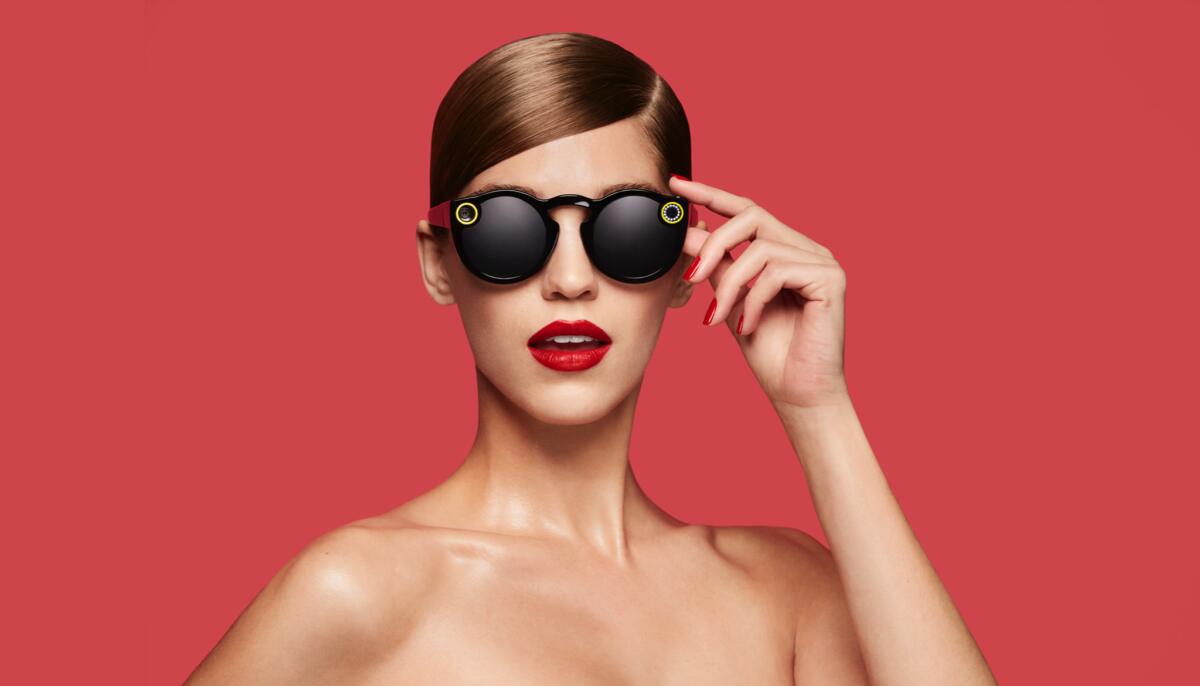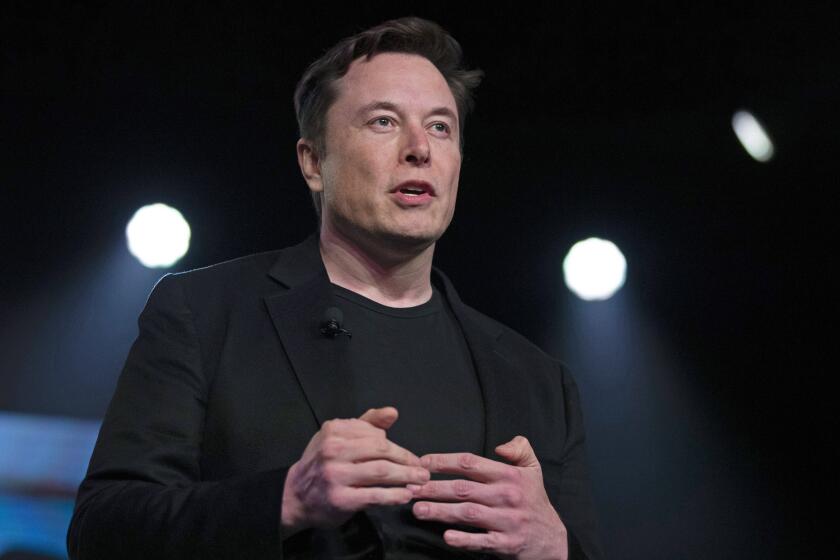Why tech’s future could bring Spotify speakers, Instacart fridges and Uber-hailing keychains

- Share via
It’s easy to imagine a future where products as mundane as toasters and window blinds will be connected to the Internet and controlled by software.
It’s harder to guess who’s going to make them.
Leading producers of consumer software such as Google, Facebook, Amazon.com and Snapchat are branching into designing physical goods at accelerating rates. Driven by intensifying competition for consumer attention and enabled by declining manufacturing costs, software companies are entering battle with firms as far-removed from Silicon Valley as Timex and Ray-Ban.
The years to come could see Amazon making bookshelves that know what’s on them, grocery delivery app Instacart peddling refrigerators that restock on their own and music streaming service Spotify designing headphones with a cellular chip and flip-down video display.
It’s all conjecture for now, but they are real considerations for software behemoths that want to solidify monopolies as well as start-ups seeking to upend traditional consumer brands, technology executives and advisers say.
Everything that’s a physical object is eventually going to be a combination of hardware and services.
— Amar Hanspal, senior vice president for products at Autodesk
“Everything that’s a physical object is eventually going to be a combination of hardware and services,” said Amar Hanspal, senior vice president for products at design software giant Autodesk. “The more industrial and complex ones are going to come from a traditional hardware company. But the more consumer-oriented and less complex, software companies will enter those product categories a lot more.”
The latest signs of that future should emerge Tuesday. Google is expected to launch Home, a $130 tabletop device comparable to an alarm clock, except it responds aloud to spoken commands and search queries. Also rumored are a Wi-Fi router and the first fully Google-branded smartphones. The unveiling caps a turnabout for a company that originally limited its mobile ambitions to supplying free software to handset makers.
Google’s announcement will come the week after Snap Inc., formerly Snapchat, shared details about $130 video-camera sunglasses it’s shipping later this year.
The convergence of hardware and software follows decades of stark separation (Bell Labs and Apple Inc. being among the few notable exceptions that pursued both). Product makers Sony and Samsung struggled to get into developing software, with bugs and poor architecture drawing negative reviews. Software vendors, used to fat profits and patching problems with updates, avoided the challenge and expense of immutable gadgets.
The rise of both smartphones and online-fueled global trade have opened doors, though, most of them in the last five years.
With more cellphones selling each year than desktops or laptops ever did, prices of Wi-Fi chips, GPS sensors and other technical parts have fallen. Devices no longer need constant tethering to an electrical outlet, mobility that’s stoking software vendors’ imaginations. And because smartphones are always on and nearby, they’re an obvious anchor for a personal gadget ecosystem.
Contract factories now can turn around orders quickly, and there’s no waiting for some massive hard drive full of schematics to move by FedEx. Online ads and shops ease distribution and marketing challenges.
These developments decreased the money and time needed to build products. Hazards remain. One miscue can devastate multimillion-dollar investments, whether it be a shipping company suddenly going bankrupt or a widespread component spontaneously catching fire (just ask Samsung).
“The biggest single thing for software people to grasp is how expensive mistakes are in hardware,” said Jeremy Conrad, founding partner at hardware startup incubator Lemnos Labs.
Increased discipline is required from Day One in hardware, a skill common among employees who have worked at big product makers, he said.
There too, software companies have benefited from the recent demise of and subsequent layoffs at onetime household names. Facebook, Google and Snap have hardware executives formerly employed by the likes of Hewlett-Packard, Nokia and Motorola.
Competition for workers is still fierce, though.
“The growth at the big companies is so fast that there’s no excess talent,” Conrad said.
Facebook is developing virtual reality headsets for watching movies and playing games. Microsoft makes gaming consoles and is branching into high-tech visors. Amazon sells a speaker with a virtual assistant built in, buttons for automatic ordering of household items, Internet entertainment access boxes and tablets. Uber is working with automotive makers on self-driving cars and trucks.
Hanspal describes efforts of Autodesk’s tech peers as exploratory. Each company wants to see if it can boost sales and usage by introducing new ways for consumers to connect.
“The more connection points, the stronger you are,” Hanspal said. “They really want to be present at all the points a consumer might decide to take a relevant action.”
See the most-read stories in Business this hour »
It’s a test, he says, of whether controlling the access lanes is just as important as owning the highways.
Apple, the world’s most valuable public company, has demonstrated the potential. The iPhone maker manages to pull billions of dollars from sales of high-priced devices and a growing sum from selling or taxing content consumed on its products.
Not every company sees devices as moneymakers. For some, it’s a defensive mechanism. In building its Spectacles, with a camera that posts video bites to its app, Snap reduces its reliance on smartphone makers for distribution. It could fear the day that Samsung builds in a 10-second video app into its smartphones and allows sharing to multiple social media services.
Being the device-maker produces unmatchable advantages, said Danny Crichton, an investor at Charles River Ventures, which has more investments in hardware startups than most venture capital firms.
A self-made device opens new advertising lanes for Snap, which is in cutthroat competition with Facebook and Google for advertisers who are shifting spending from TV to the Internet.
“There’s been so much consolidation of attention to Apple and Android on the devices side and to Facebook and Google on the advertising side, that the desire of many of these software companies to find a unique way to engage customers is increasing,” said Charles Golvin, research director at tech consulting firm Gartner.
Developing hardware isn’t a perfect solution. Gadgets can become cheap and indistinguishable over time. But the ecosystem of product, service and large user community is better than any one of those on their own, Golvin said.
“Hardware can be commoditized,” he said. “The competition can leapfrog you, but your customers are secured by the services and community tied to that. That’s where you have to focus.”
Other companies including Netflix and Spotify are choosing an agnostic approach, making sure their apps are accessible on whatever products come about. At some point, they must ask, ‘Why live for a competitor’s device?’ Crichton said. They could at least wade into exclusive arrangements with existing product-makers to shut out rivals, a tactic Google reportedly has considered.
Imagine a Bluetooth-connected keychain that hails an Uber with a press of a button and has a tiny screen listing the car’s license plate.
This type of exclusive device would be compelling for Uber because users would be less likely to think about rival Lyft, Crichton said.
Technology experts say companies shouldn’t stray from their core identities with hardware. For Google, TVs could be OK, but probably not coffee mugs, Conrad speculated.
Companies also appear to have heeded lessons. A company’s devices are generally compatible with those of other manufacturers, unlike in the past, and they’re all more thoughtful about conducting trials, integrating personalization and stunning with appealing aesthetics.
The next big separator may be who nails the tech industry’s move toward predictive virtual assistants, Golvin said. The company that anticipates people’s needs and does the best job fulfilling them could have the most dominant hardware-meets-software ecosystem.
Twitter: @peard33
ALSO
Pasadena, other California cities weigh taxing Netflix and other video services
Consumers aren’t as excited as the auto industry about self-driving cars
Airbnb takes a toll on the U.S. lodging industry, but Los Angeles hotels continue to thrive




